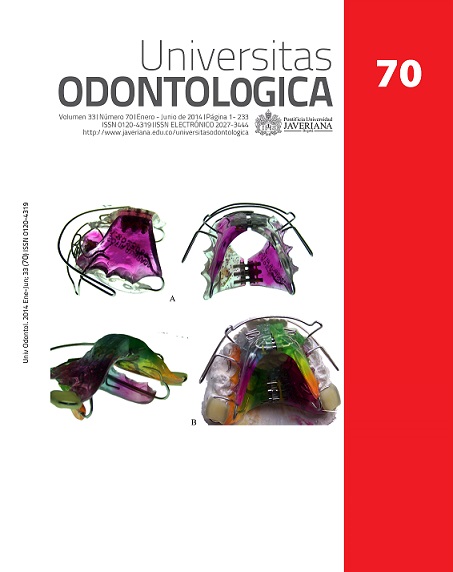Resumen
Introducción: El análisis de Wala Ridge es una herramienta para la evaluación transversal del arco inferior, que permite determinar la cantidad de desarrollo transversal que se obtendrá con el tratamiento ortodóncico. Nuestro objetivo fue evaluar el arco inferior en pacientes tratados con sistemas de autoligado mediante el análisis de Wala Ridge. Métodos: Tomamos 39 pacientes tratados con los sistemas Damon, Quick e In-Ovation en el (XXXX) de Bogotá. Sobre sus modelos inferiores se realizaron las medidas de Wala Ridge a nivel de caninos, primero y segundo premolares, y primero y segundo molares, comparándolas posteriormente se con las del Dr. Andrews que son 0.6, 0.8, 1.3, 2.0 y 2.2 respectivamente. Resultados: Las medidas en el sistema Damon fueron 0.4, 0.4, 1.3, 1.9 y 1.8. En el sistema Quick las medidas encontradas fueron 0.4, 0.7, 1.3, 2.0 y 2.0. En el sistema In-Ovation se obtuvieron 0.2, 0.4, 1.3, 1.9 y 2.0, a nivel de caninos, primer y segundo premolares, y primer y segundo molares, respectivamente. Conclusión: Ninguno de los sistemas usados lograron en todos los dientes los valores ideales pos-tratamiento sugeridos por el Dr. Andrews. El sistema que más se acercó a las medidas sugeridas por el Dr. Andrews fue Quick.
Palabras clave: Ortodoncia, Wala Ridge, desarrollo transversal, arco inferior.
Esta revista científica se encuentra registrada bajo la licencia Creative Commons Reconocimiento 4.0 Internacional. Por lo tanto, esta obra se puede reproducir, distribuir y comunicar públicamente en formato digital, siempre que se reconozca el nombre de los autores y a la Pontificia Universidad Javeriana. Se permite citar, adaptar, transformar, autoarchivar, republicar y crear a partir del material, para cualquier finalidad (incluso comercial), siempre que se reconozca adecuadamente la autoría, se proporcione un enlace a la obra original y se indique si se han realizado cambios. La Pontificia Universidad Javeriana no retiene los derechos sobre las obras publicadas y los contenidos son responsabilidad exclusiva de los autores, quienes conservan sus derechos morales, intelectuales, de privacidad y publicidad.
El aval sobre la intervención de la obra (revisión, corrección de estilo, traducción, diagramación) y su posterior divulgación se otorga mediante una licencia de uso y no a través de una cesión de derechos, lo que representa que la revista y la Pontificia Universidad Javeriana se eximen de cualquier responsabilidad que se pueda derivar de una mala práctica ética por parte de los autores. En consecuencia de la protección brindada por la licencia de uso, la revista no se encuentra en la obligación de publicar retractaciones o modificar la información ya publicada, a no ser que la errata surja del proceso de gestión editorial. La publicación de contenidos en esta revista no representa regalías para los contribuyentes.


